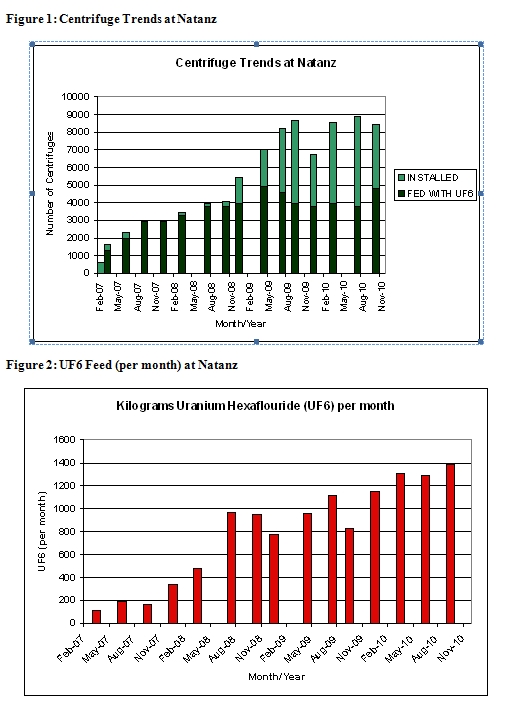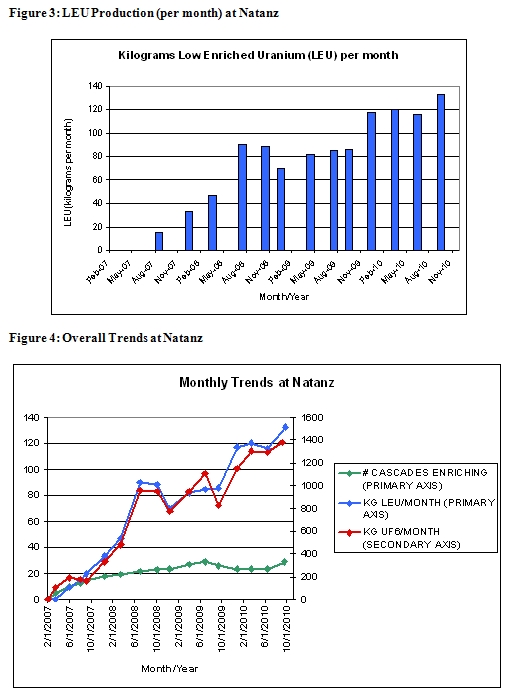Reports
IAEA Iran Safeguards Report: Shutdown of Enrichment at Natanz Result of Stuxnet Virus? Downgrade in Role of Fordow Enrichment Site; LEU Production May Have Decreased
by David Albright, Andrea Stricker, and Christina Walrond
November 23, 2010
The International Atomic Energy Agency (IAEA) released on November 23, 2010 its latest report on the implementation of NPT safeguards in Iran and the status of Iran’s compliance with Security Council Resolutions 1737, 1747, and 1803. The following analysis highlights the IAEA’s key findings, including 1) a mysterious halt to enrichment at Natanz resulted in centrifuges not enriching for up to one week during November 2010, which ISIS speculates could have been the result of the Stuxnet virus; 2) fewer P1 centrifuges are planned for the Fordow enrichment site; and 3) the average monthly rate of low enriched uranium production increased but many additional centrifuges enriching by end of reporting period; and 4) monthly production rates of 20 percent enriched LEU remain steady.
Stuxnet Attack?
According to the Associated Press, the centrifuges in the Fuel Enrichment Plant (FEP) recently suffered serious fluctuations, including a rare halt to the enrichment of uranium in the entire plant. A senior U.S. administration official confirmed to ISIS that this did indeed happen.
According to the IAEA report, on November 16, 2010, no cascades were being fed uranium hexafluoride. About a week later, Iran informed the IAEA that 28 cascades were being fed with uranium hexafluoride. This shutdown remains hard to evaluate. Was the Stuxnet worm responsible for these disruptions, or were they caused by some other event or problem? U.S. officials declined to comment.
The impact on the plant’s operation is difficult to judge. Was equipment destroyed? Iran says that it was not, but it may be inclined to deny that it was victim to a foreign cyber attack. On November 23, Ali Akbar Salehi, the head of Iran’s Atomic Energy Organization, confirmed to IRNA that the virus had indeed reached Iran: “One year and several months ago, Westerners sent a virus to (our) country’s nuclear sites.” Yet, he continued, “…We discovered the virus exactly at the same spot it wanted to penetrate because of our vigilance and prevented the virus from harming (equipment).”
If the attack started prior to this shutdown, were LEU production levels affected? During the last reporting period, LEU production levels do not appear to have been significantly affected when considering monthly LEU production levels (see below). However, LEU output could have been impacted in such a way that is not apparent in multi-month LEU total estimates.
For more information on the possible effects of the Stuxnet virus on centrifuges, see ISIS’s recent analysis: Stuxnet Worm Targets Automated Systems for Frequency Converters: Are Iranian Centrifuges the Target?
Fewer P1 centrifuges planned at the Fordow Enrichment Site
Iran has told the IAEA that it plans to reduce by one third the number of P1 centrifuges at the Fordow site in Qom, supporting assessments that after its discovery by Western intelligence, Iran would downgrade the role of the Fordow plant as a centrifuge plant. Instead of 16 cascades, the plant will now hold only twelve cascades of P1 centrifuges. The other four cascades will be used as a research and development test facility. Iran stated it will test advanced centrifuges at this site. One source stated that it would test advanced centrifuges there, including a new IR-5 centrifuge.
The reduction in the planned number of P1 centrifuges at Fordow suggests that Iran could be de-emphasizing the site following its discovery and will concentrate on constructing new secret sites, at least one of which it has announced it will start building early next year. Although Iran says it will eventually declare those sites to the IAEA, doubts remain. In several cases, including with Natanz, Kalaye Electric, Lavizan Shian, and now the Fordow site, Iran only declared the formerly secret sites after their discovery by other nations and groups. The new developments at Fordow also contradict speculation that Iran wants to build and operate many centrifuge plants at once, as opposed to what it now appears to be doing—building multiple facilities that will not be outfitted with large numbers of centrifuges unless they can remain secret sites that could be used in a breakout.
LEU production and centrifuge levels at Natanz Fuel Enrichment Plant
Iran’s total LEU production at the Natanz fuel enrichment plant (FEP) to October 31 is reported to be 3,183 kg of low enriched uranium hexafluoride, including 380 kg estimated by Iran to have been produced since August 6, 2010. The FEP is Iran’s primary enrichment facility, where the majority of its IR-1 centrifuges are installed. Activity at the pilot fuel enrichment plant, where Iran has begun to enrich uranium up to the 20 percent level, is discussed below.
The average monthly production of LEU at the FEP has increased slightly to about 133 kg per month of LEU hexafluoride (for the last reporting period we noted it was 116 kg of LEU and the one prior to that it was 120 kg of LEU). As of November 5, 2010, Iran was enriching in 29 cascades with 4,816 P1 centrifuges, up from 3,772 centrifuges at the end of the last reporting period. Some 3,610 centrifuges are installed but not being fed with uranium hexafluoride, according to this report. The total number in the FEP is 8,426 P1 centrifuges, down slightly from 8,856 IR-1 centrifuges at the end of the last reporting period. Figures 1-4 display these trends at Natanz.
On November 16, 2010, Iran stopped enriching and resumed by November 22, 2010, at which point 28 cascades were being fed with uranium hexafluoride.
Because 1,044 additional centrifuges started to enrich by the end of this reporting period, the average monthly LEU production needs to be adjusted. At the end of the previous reporting period, the average value was 0.0313 kg per month per centrifuge. At the end of this reporting period, the average value is 0.028 kg per month per centrifuge, about ten percent lower than in the last reporting period. However, these values are difficult to interpret because the average number of centrifuges operating during each reporting period is not known.
Activity at the Pilot Fuel Enrichment Plant
Iran has designated two cascades at the smaller, above-ground pilot fuel enrichment plant for the production of LEU enriched to nearly 20 percent uranium 235 for the Tehran Research Reactor. One of these cascades enriches from 3.5 percent LEU to almost 20 percent LEU, while the second one takes the tails from the first one and outputs about 10 percent LEU and a tails of natural uranium. The ten percent material is fed into the first cascade in addition to 3.5 percent LEU. This process allows Iran to more efficiently use its 3.5 percent LEU stock.
Between February 9 and September 18, 2010, 352 kg of 3.5 percent low enriched uranium in the form of uranium hexafluoride was introduced into the single cascade, and Iran withdrew a total of 25.1 kg of nearly 20 percent LEU hexafluoride and stored it in a small cylinder. Iran estimates that it produced 7.8 kg of 20 percent enriched uranium from September 19 to November 19. Thus, Iran has produced about 33 kg in total of 20 percent enriched material since February 2010, reflecting an average production rate of almost 3.5 kg per month. According to Iran’s statements to the IAEA, its monthly production rate of 20 percent enriched uranium between September and November would have been 3.9 kg per month, but the IAEA has not yet verified this estimate.



 twitter
twitter